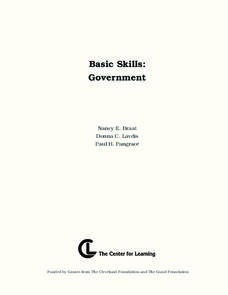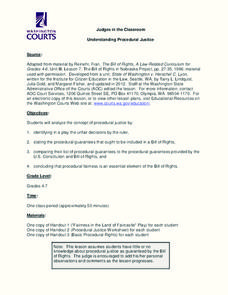Curated OER
The Bill of Rights
Learners classify the Bill of Rights. In this U.S. Constitution lesson plan, students complete provided readings and worksheets in order to define, identify and analyze each of the amendments and explain why they were included in...
Curated OER
The Bills of Rights: Cutting It down to Size
Eighth graders explore democratic values. For this U. S. Constitution lesson, 8th graders read the Bill of Rights and consider the significance of the amendments. Students design a governmental time capsule that includes their own plan...
Curated OER
The Role of the Executive Branch in the Lawmaking Process
Students research the Executive Branches role in making a law. In this law making lesson plan, students study the history of the Constitution and see how much power the President has in making a bill into a law. Students then research on...
Curated OER
Citizen Juries: Zacarias Moussaoui - May 1, 2006
Students consider deliberations by juries. In this citizen jury lesson, students complete readings regarding the constitutional right to a trial by jury as well as on the civic responsibility to serve on a jury.
Curated OER
How is Our Government Organized?
Students explore rights of their clients. In this constitutional law lesson, students play an online game that requires them to review individual cases in order to determine the rights their clients have.
Curated OER
Understanding Procedural Justice
Learners analyze the concept of procedural justice. In this judges in the classroom instructional activity, students role play the ways the U.S. Constitution and Bill of Rights established certain procedures to protect people from...
Curated OER
Dekanawidah- A Forgotten Founding Father
Students compare plans for government. In this early American history lesson, students compare and contrast the U.S. Constitution with the Iroquois Constitution. Students identify cultural features, government functions, and citizenship...
Curated OER
Lesson Plan: U.S. Government
Students examine reasons for studying government. In this U.S. government lesson, students brainstorm the reasons for rules. Students draft their own class constitution in the style of the U.S. Constitution.
Curated OER
The Second Amendment and the Right to Bear Arms
High schoolers interpret the Second Amendment. In this U.S. Constitution lesson, students examine the right to bear arms as they compare 2 Michigan Supreme Court cases and discuss their personal interpretations of the amendment.
Curated OER
The First American Party System: Events, Issues, and Positions
Students examine and discuss the philosophical differences that arose during the Constitutional Convention and how these differences played a role in the formation of the first political parties.
Curated OER
The Preamble
Students read and analyze the meaning of the Preamble to the U.S. Constitution. They read and discuss the Preamble, look up difficult words in a dictionary, rewrite the Preamble in more common words, and create posters displaying the...
Curated OER
Participating in State and Local Government
Students analyze the structure, organization, and powers of State legislatures. They outline the overall shape of the office of the governor.
Students analyze the structure of local governments as creations of the State. They describe...
Curated OER
America: Influenced by the Enlightenment
In this Enlightenment influence study guide worksheet, students read 5 quotes from the Declaration of Independence and the U.S. Constitution and then respond to 5 reflection questions.
Curated OER
Checks and Balances Chart
In this checks and balances chart worksheet, students use their textbooks and a copy of the U.S. Constitution to complete 10 items in the chart identifying the branches of government.
Curated OER
iCivics: State Government
Young scholars explore the role of state government. In this civics lesson, students play an online game that requires them to consider the needs of state residents and the structure of state government.
Curated OER
Legislative Branch
Students analyze Article 1 of the Constitution. They respond to the Public Criticism E-Learning module.
Curated OER
U.S. History Worksheet #73
Explore how the 14th Amendment changed the way the United States operated, both politicallay and socially. In this United States history worksheet, students utilize a word bank of 10 terms or phrases to answer 10 fill in the blank...
Curated OER
The Constitution: Our Plan for Government
Students investigate the importance of separation of powers, checks, balances, and judicial review. They also investigate how national and state governments are linked.
Curated OER
The Inauguration and the Constitution
Students read the sections of the US Constitution that discuss the elements of the inauguration. They study how the inauguration symbolizes the peaceful transition of power in a democratic republic and show the parts of the inauguration...
Curated OER
Ratification Debate on the U.S. Constitution
Young scholars study the U.S. Constitution and are asked to give a speech about what they have found.
Curated OER
Supreme court Decisions on Freedom of Religion
Eleventh graders analyze the limits and bounds of religious freedom issues in the United States through several Supreme Court case decisions.
Curated OER
Constitutional Amendments Survey
Young scholars conduct Constitutional Amendments Survey to create an opinion poll forum.
Judicial Learning Center
Levels of the Federal Courts
The Supreme Court gets all the glory, but very few federal cases make it to the highest court. An interesting lesson explores the structure of the lower levels of the federal court system. In addition to outlining the organization of...
Judicial Learning Center
The Power of Judicial Review
Marbury v. Madison is arguably the most important landmark case in the history of the Supreme Court. A fact-filled lesson provides background information about the case and two others related to the concept of judicial review. Scholars...

























